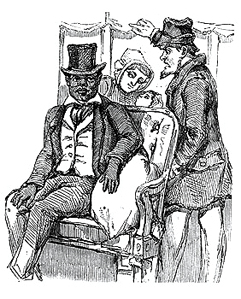
Library of CongressAfrican American is kicked out of a train compartment in Philadelphia: drawing by unknown author published in 1856 in the Illustrated London News magazine.Library of Congress
The United States takes prides in having assimilated a melting pot of cultures and ethnic races – this melting pot is frequently indicated as one of the engines of the progress of this world power. Hence the astonishment of geneticist Sérgio Danilo Pena, a professor at the Federal University of Minas Gerais (UFMG), when he analyzed the sequencing of mitochondrial DNA of Caucasian North Americans stored in the data base used by the FBI, the US’s federal police department, for legal purposes. The professor was doing research on the genetic origin of Caucasian Americans.
The researcher found an exceptionally low miscegenation rate. Only 3.1% of the samples revealed any traces of African or American Indian ascendancy. The researcher analyzed samples of 1,387 individuals. Only 31 showed Asian or American Indian genetic traces, while 13 had African DNA strains. This number contrasts strongly with the findings in the Causcasian population in Brazil and in Latin American countries and in the US’s African American population. In these groups, miscegenation is characterized by an African component which is more evident on the maternal side. The European component is more often found in the male genes, evidence of the sexual exploitation of black women by white men before the abolition of slavery .
In the article “Sex-biased gene flow in African Americans but not in American Caucasians”, recently published in the Genetics and Molecular Research journal, Pena and his team from the UFMG Biochemistry and Immunology Department found a simple reason for this discrepancy: miscegenation is low because of the strict racial classification in the United States, a legacy from slavery and explicit segregation. This criterion was in effect from the 18th century until the late 60’s, when it was declared unconstitutional. But it still influences the country’s customs.
Referred to as “the one drop rule” – a single drop of black blood classifies the individual as being black ?, this segregationist form of classification, according to which even a black great-great grandfather (the proportion is 1/32 African ascendancy) defines that the individual is black, the rule was adopted under the pretext of deciding the destiny of the offspring of slaves with whites. However, this rule became one of the cornerstones of US racism, because it strongly discouraged mixed marriages. “It makes all the sense in the world that those samples have so few traces of African or American Indian ancestors. If they had these traces, these people would not have been classified as being white,” states the researcher.
When slavery existed in Brazil, the definition of race depended greatly on the appearance of the person of mixed race – if he were light-skinned, he was allowed to live in the master’s house. “Social practices in the United States and in Latin America differ significantly. This research shows that racial classification can play an important role in inter-racial relationships and that molecular genetics is a powerful ally of the social sciences,” says Pena.
Facial features
The research on the Caucasian Americans taught the UFMG professor a lesson: “It is easier to explain a phenomenon than it is to predict it.” In the late 90’s, the professor had no idea what he would find when he started to research the genetic origin of 200 white Brazilians, of several backgrounds and from several regions in the country. The researchers examined a variation of the exclusively male Y chromosome as the biological marker and mitochondrial DNA, found in the mitochondria, which is considered as one of the most accurate indicators of the mother’s legacy. They found that among white Brazilians, some 60% of the maternal lineages are of American Indian or African origin, whereas the vast majority (more than 95%) of the paternal lineages of white Brazilians were of European origin. Therefore, less than one out of every 20 Brazilian whites have American Indian or African paternal ascendancy. However, on the maternal side, six out of every ten Brazilians have African or American Indian ascendancy on the mother’s side.
Miscegenation does not necessarily translate into facial features or skin color; however, the racial mixture among the people who colonized Brazil is more intense than previously imagined. The research study was published in 2000, during the festivities to celebrate the 500th anniversary of the Portuguese explorers’ arrival in Brazil. A more recent study focused on the genetic inheritance of African Brazilians (see Pesquisa FAPESP 134). The genetic material analyzed by Pena and by Maria Cátira Bortolini, from the Federal University of Rio Grande do Sul, showed that 85% of African Brazilians have one African ancestor, but only 47% carry African lineages inherited from the males – the rest have European ancestors on the male side.
Republish